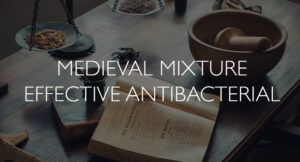 Infections associated with #biofilms are notoriously difficult to treat and play a large role in #antibiotic resistance, a significant emerging health problem. It is estimated that Antimicrobial resistance will kill 10 million people per year by 2050. Scientists from Warwick University have recognised the need for new #antimicrobials to fight antibiotic resistance and have had their work published in the Nature Journal in July 2020. In conjunction with medievalists the team of microbiologists, chemists, pharmacists, and data analysts recreated a 1000-year-old medicinal preparation called Bald’s eye salve using extracts of “onion, garlic, wine, and bile salts” and found it to have strong antibacterial activity.
Infections associated with #biofilms are notoriously difficult to treat and play a large role in #antibiotic resistance, a significant emerging health problem. It is estimated that Antimicrobial resistance will kill 10 million people per year by 2050. Scientists from Warwick University have recognised the need for new #antimicrobials to fight antibiotic resistance and have had their work published in the Nature Journal in July 2020. In conjunction with medievalists the team of microbiologists, chemists, pharmacists, and data analysts recreated a 1000-year-old medicinal preparation called Bald’s eye salve using extracts of “onion, garlic, wine, and bile salts” and found it to have strong antibacterial activity.
Biofilms are membranes produced by microbes to colonise surfaces, they protect bacteria from the body’s immune system and increase their resistance to antibiotics, making them hard to treat. As an example, the biofilms that infect diabetic foot ulcers have proven incredibly hard to treat leading to amputations to avoid the risk of the bacteria spreading to the blood. The team from Warwick found that the Bald’s eye salve remedy was effective against a range of #Gram-negative and #Gram-positive #wound #pathogens in #planktonic culture. Crucially this activity was found to be maintained against the following five pathogens grown as biofilms:
- Acinetobacter baumanii- commonly associated with infected wounds in combat troops returning from conflict zones.
- Stenotrophomonas maltophilia- commonly associated with respiratory infections in humans
- Staphylococcus aureus- acommon cause of skin infections including abscesses, respiratory infections such as sinusitis, and food poisoning.
- Staphylococcus epidermidis-a common cause of infections involving indwelling foreign devices such as a catheter, surgical wound infections, and bacteraemia in immunocompromised patients.
- Streptococcus pyogenes– cause numerous infections in humans including pharyngitis, tonsillitis, scarlet fever, cellulitis, rheumatic fever, and post-streptococcal glomerulonephritis.
Bald’s eye salve came from Bald’s Leechbook, which is widely known as one of the earliest medical textbooks. The mixture has not caused harm to human cells in the lab or to mice so offers hope as an effective treatment. As part of their conclusion the research team stress the importance of considering not just single components when looking for new plant-based antibiotics but to instead study the effects from using a combination of ingredients. Each ingredient of Bald’s eye salve had known antimicrobial properties or compounds, with garlic showing strong planktonic activity. In the more clinically relevant setting against S. aureus Newman biofilms, grown in a synthetic wound model, there was only anti-biofilm activity when the mixture of all four ingredients were used.






2 Comments. Leave new
Hey Michael,
Thanks for this article! I also read an interview you did with Peta Cohen in 2004 which was also very interesting:
https://www.clinicaleducation.org/resources/reviews/dissolve-biofilms-with-fibrinolytic-enzymes-autism-support/comment-page-1/#comment-20228
After reading that article I had two questions that came to my mind, I hope you could help me a bit:
“for years, I knew from organic acid testing, from the short-chain fatty acids and metabolites the children were excreting, that they carried these infections.”
1. Do we know for sure that increased short-chain fatty acids in feces are predictive for a bacterial infection? Which metabolites are meant over here?
2. When minerals are used by bacteria in creating the biofilm, do we suspect a decrease or increase in serum/blood mineral levels such as magnesium and zinc? I would guess a decrease right, or is my thinking not right?
Thanks!
Kind regards,
Thom
Hi Thom
Thanks for your questions.
Translating SCFA analytes to specific pathogens is not currently reliable, but changes in SCFA analytes can provide indicative dysbiosis events/organisms.
To my knowledge, there is no association between blood (or intracellular) levels of magnesium and biofilm formation.